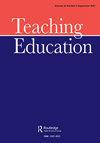Why to become a teacher in Iran: a FIT-choice study
IF 1.1
Q2 EDUCATION & EDUCATIONAL RESEARCH
引用次数: 2
Abstract
ABSTRACT Teaching motivations have recently received wide research attention. The FIT-Choice model (Factors Influencing Teaching Choice) comprising different motivations and perceptions of teaching has been used in different countries to research teaching motivations. In this study, using a valid Persian language version of the FIT-Choice scale, motivations, and perceptions of the teaching of 527 Iranian student teachers were studied. Results showed that some sub-constructs of the FIT-choice model changed or merged with the Iranian sample. The sacredness of the teaching job, which was added to the scale as a separate motivation, did not form a new kind of motivation and was merged with social contribution motivation. In the new structure, social/spiritual function and ability-intrinsic value were the highest motivations, while time for family, and fallback career were the lowest motivations. Moreover, although student teachers viewed teaching as a difficult, poorly-paid job that requires expertise, they were satisfied with their choice of teaching. Results also showed that male and female, science and non-science, and undergraduate and graduate teacher education candidates had different motivations and perceptions.为什么要在伊朗成为一名教师:一项fit选择研究
摘要教学动机近年来受到了广泛的研究关注。FIT Choice模型(影响教学选择的因素)包含了不同的教学动机和对教学的看法,已在不同国家被用于研究教学动机。在本研究中,使用有效的波斯语版本的FIT Choice量表,研究了527名伊朗学生教师的教学动机和认知。结果表明,FIT选择模型的一些子结构与伊朗样本发生了变化或合并。教师工作的神圣性作为一种单独的动机被添加到量表中,但并没有形成一种新的动机,而是与社会贡献动机相融合。在新的结构中,社会/精神功能和能力内在价值是最高的动机,而家庭时间和后备职业是最低的动机。此外,尽管实习教师认为教学是一项困难、报酬低、需要专业知识的工作,但他们对自己的教学选择感到满意。研究结果还表明,男性和女性、科学和非科学、本科生和研究生教师教育候选人有不同的动机和看法。
本文章由计算机程序翻译,如有差异,请以英文原文为准。
求助全文
约1分钟内获得全文
求助全文
来源期刊

Teaching Education
EDUCATION & EDUCATIONAL RESEARCH-
CiteScore
3.80
自引率
6.20%
发文量
15
期刊介绍:
Teaching Education is an interdisciplinary forum for innovative practices and research in teacher education. Submission of manuscripts from educational researchers, teacher educators and practicing teachers is encouraged. Contributions are invited which address social and cultural, practical and theoretical aspects of teacher education in university-, college-, and school-based contexts. The journal’s focus is on the challenges and possibilities of rapid social and cultural change for teacher education and, more broadly, for the transformation of education. These challenges include: the impact of new cultures and globalisation on curriculum and pedagogy; new collaborations and partnerships between universities, schools and other social service agencies; the consequences of new community and family configurations for teachers’ work; generational and cultural change in schools and teacher education institutions; new technologies and education; and the impact of higher education policy and funding on teacher education. Manuscripts addressing critical and theory-based research or scholarly reflections and debate on contemporary issues related to teacher education, will be considered. Papers should attempt to present research, innovative theoretical and/or practical insights in relevant current literature and debate.
 求助内容:
求助内容: 应助结果提醒方式:
应助结果提醒方式:


